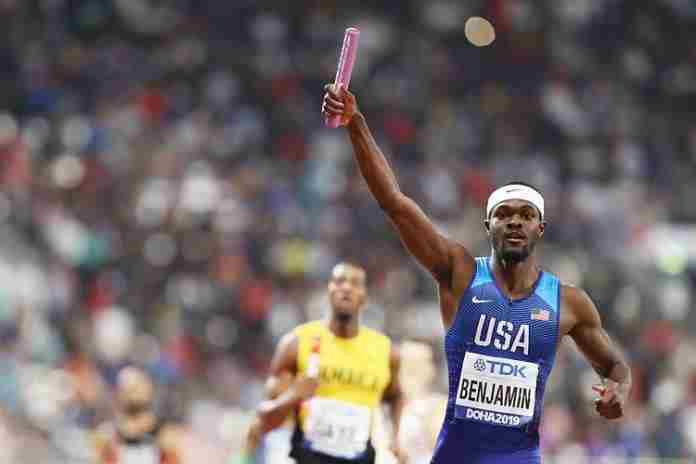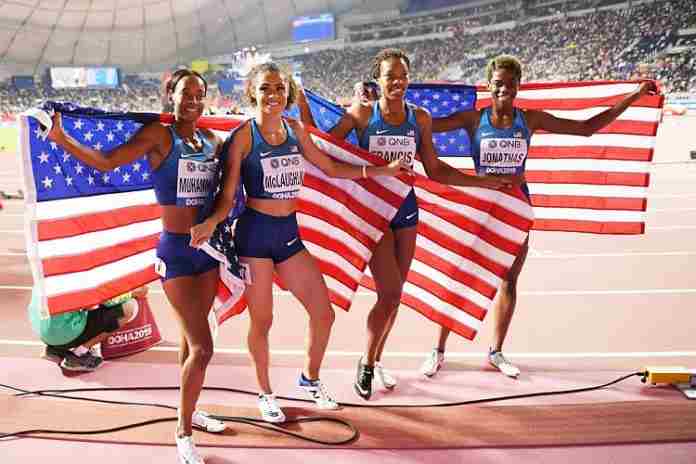 The 2019 IAAF World Championships was mired in controversy as soon as it was awarded to Doha, Qatar in 2014 and scheduled to begin a month later than any Worlds had ever been held.
The 2019 IAAF World Championships was mired in controversy as soon as it was awarded to Doha, Qatar in 2014 and scheduled to begin a month later than any Worlds had ever been held.
Now that the meet has concluded, what did we learn?
(1) No matter when the meet or the conditions, the competition was spectacular!
What other conclusion is there from the 10 days of Doha? Two world records – by Dalilah Muhammad in the women’s 400 m hurdles and the U.S. in the Mixed 4×400 m – and 18 world-leading marks for 2019 (out of 49 events) at a time when the season is usually over for a month.
Out of the 49 total events – one was new, the Mixed 4×400 – there were 37 new champions and 12 repeaters from 2017. The defenders who won again:
● Men/3,000 m Steeple: Conseslus Kipruto (KEN)
● Men/5000 m: Muktar Edris (ETH)
● Men/400 m hurdles: Karsten Warholm (NOR)
● Men/High Jump: Mutaz Essa Barshim (QAT)
● Men/Pole Vault: Sam Kendricks (USA)
● Men/Triple Jump: Christian Taylor (USA)
● Men/Hammer: Pawel Fajdek (POL)
● Women/5,000 m: Hellen Obiri (KEN)
● Women/4×400 m: United States
● Women/High Jump: Mariya Lasitskene (RUS)
● Women/Triple Jump: Yulimar Rojas (VEN)
● Women/Shot Put: Lijiao Gong (CHN)
There were eight men’s world leaders and 10 for the women. The races were close and fast, even in the distance events and the field events were mostly excellent, notably the vault duel between Kendricks and Mondo Duplantis (SWE) and the men’s shot put with Americans Joe Kovacs and Ryan Crouser, New Zealand’s Tom Walsh and Brazil’s Darlan Romani. Just tremendous and some of the best events ever seen.
(2) Doha showcased a new set of stars for both men and women, and some old stars still shining
One of the important aspects of a world championships in a year prior to the Olympic Games is to place a spotlight on the athletes who will be the stories on the much larger stage in Tokyo at the 2020 Olympic Games. Great stories were everywhere in Doha:
● In the men’s sprints, the U.S. is suddenly back on the throne, thanks to wins by Christian Coleman, Noah Lyles, Grant Holloway and a sensational 4×100 m relay final … after almost being disqualified in the heats.
● The 400 m hurdles, with Norway’s Karsten Warholm, Rai Benjamin of the U.S. and a healthier Abderrahmane Samba (QAT) will rival the interest in the event during the Edwin Moses era.
● The distance races had drama and were anything but boring. Kenyans Tim Cheruiyot and Conseslus Kipruto could be breakthrough stars in Tokyo next year for their fearless attitudes and Kipruto’s antics, especially when he is telling fellow Kenyans what they should be doing … during his races!
● Can you do better in the men’s field events than Kendricks vs. Duplantis, Taylor vs. Will Claye in the triple jump and the shot put? No is the answer. Don’t forget that Kendricks has asked for a rule change which would strip Duplantis of his 2018 American Record – remember, he’s a U.S. citizen – set at the European Championships!
● The women’s sprints were be all about Jamaica’s Shelly-Ann Fraser-Pryce trying for a third 100 m Olympic title … and what color hair she will wear for each round. She’s a one-woman fashion show and surely must have a hair color sponsor by now!
● The women’s 400 m could be one of the focus points in Tokyo. Bahraini Salwa Eid Naser ended the reign of Shaunae Miller-Uibo (BAH) as World Champion and a two-year unbeaten streak. Challenging them could be … Allyson Felix? She has a long way to go to be competitive again, but she has been on a steady rise since returning from maternity at the USATF Nationals. She ran 50.4 and 49.8 on her relay legs in the Mixed 4×400 final and the heats of the women’s 4×400 and started to look like the Felix of old. With another year of training ahead, what is possible? Given Felix’s work ethic, quite a bit.
● Dutch distance star Sifan Hassan is going to need a public relations director over the next year to handle the tsunami of interview requests, not only for her amazing 1,500/10,000 m double – both in world-leading times – but to handle the controversy surrounding her now-suspended coach, Alberto Salazar of the Nike Oregon Project. Hassan’s story as an Ethiopian refugee made good could be eclipsed by the Salazar story and that would be a shame. She will also be relentlessly tested by the U.S. Anti-Doping Agency since she trains in the U.S.
● The Muhammad vs. Sydney McLaughlin story is only starting. They were 2-2 this year and it took Muhammad’s two world records to beat McLaughlin.
● The best story in the women’s field events, especially for U.S. audiences, will be DeAnna Price and the women’s hammer. She broke through with the first-ever U.S. medal in the women’s hammer at the Worlds and she will now take on the American 0-for-Olympics drought in the same event. Poland’s world-record holder Anita Wlodarczyk should be back from injury for 2020, so the task will be tougher.
(3) The U.S. team is really, really good and could be better in 2020
The days of the U.S. team under-achieving at the World Championships appear to be over.
In this decade, the U.S. medal production has totaled 28-26-18-30-29 in Daegu, Moscow, Beijing, London and Doha. In 2019, American athletes won 14 golds; the next highest was Kenya with five. The U.S. won 11 silvers and four bronzes and no one else was close.
Second-best in terms of total medals was Jamaica with 12, then Kenya with 11 and China with nine (mostly in the walking events). In the placing table – the best indicator of team strength, with the top eight places scored 8-7-6-5-4-3-2-1 – the U.S. was amazing:
1. 310 points United States
2. 122 points Kenya
3. 115 points Jamaica
4. 99 points China
5. 83 points Ethiopia
You get the idea. And there were injuries that kept away or caused poor performances from Evan Jager, Michael Norman, Tori Bowie and more.
This is good with the 2021 Worlds coming to the U.S., at the new Hayward Field. But it’s bad news for the rest of the world.
(4) The IAAF is working hard to make things more interesting, and succeeding in some areas
There are people who will never forgive the IAAF for going to Doha, like the folks working for British television. But that doesn’t mean there weren’t positives.
The gaudy light show for the last final of each night was not introduced well on NBC’s broadcasts, but if you watched every day, the program became clearer as the meet went on. There were two such programs on the final evening, for the 4×400 m relays.
The awards ceremonies, with separate huge screens to show each medalist, were great, and the Khalifa International Stadium had the space for this kind of showcase. Very impressive.
Although it did not do anything new for the 2019 Worlds, the IAAF’s information program for those either in the stadium or watching at home, was superb. The results were fast and deep, there was a live blog, photo galleries, videos, live radio during each session and the live timing page was easy to follow and rendered very quickly. The skiing folks at FIS are just as good for their World Championships, but there is no one better at this anywhere than the IAAF.
(5) The Doha folks did their best, but there was no getting away from the weather
The organizing committee was clearly in overdrive during the event to try and get more spectators in the stadium. Banners covered much of the facility during the early days, reducing the capacity from 48,000 to a reported 21,000. Even so, it didn’t really fill up until last Friday, when the men’s high jump was held, with local hero Barshim defending his title memorably. The BBC reported attendance on this day at over 40,000!
The crowds on Saturday and Sunday were good, but not at capacity.
The meet generally ran on time and the air-conditioning system in the stadium worked well enough to keep the temperatures bearable, reportedly in the 78-80 degrees (F) realm.
Those were the good things, but there was no relief from the heat and humidity once you left the stadium and the outdoor events – the marathons and walks – were held in very difficult conditions, even though they were held in the middle of the night.
Moreover, the heat caused the meet to be run in single sessions of as much as six and seven hours (!) in length, exactly the wrong format to maximize worldwide television interest.
Doha was not the best choice for the IAAF, but that decision was made – as previously noted – during the Lamine Diack regime. To his credit, current IAAF President Sebastian Coe never mentioned that fact and defended the choice as bringing the sport to a new area. Certainly, the political isolation and commercial boycott of Qatar by its neighbors hurt badly.
But the Worlds came off, and there were valuable lessons for future events coming to Doha, such as the 2022 FIFA World Cup and the 2023 World Aquatics Championships.
For the IAAF, it can say it placed its most important meet in the Middle East and in a Muslim-majority country, and the performances were outstanding. Surely the next project is Africa, and Coe already has stated his interest in considering Kenya for 2025. Good news: the average high in August in Nairobi is 72 degrees, with little rainfall.
Rich Perelman
Editor
If you enjoyed this commentary, sign up to receive our exclusive TSX Report by e-mail by clicking here. You can also refer a friend by clicking here.

























